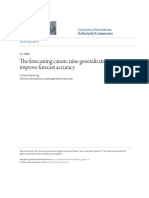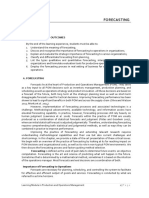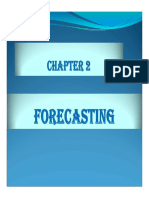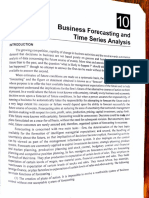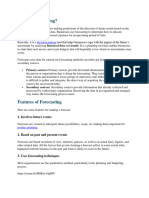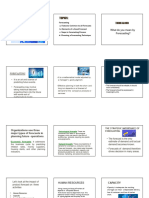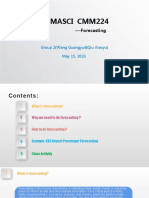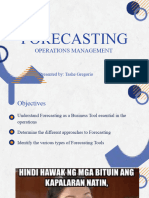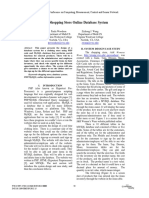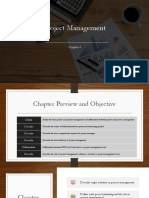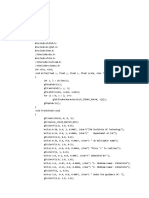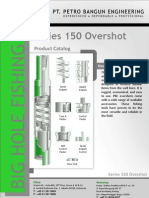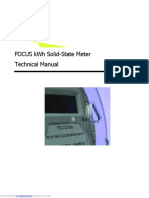The Use of Some Forecasting Methods and SWOT Analysis in The Selected Processes of Foundry
Uploaded by
Haifa Fitriya QolbyThe Use of Some Forecasting Methods and SWOT Analysis in The Selected Processes of Foundry
Uploaded by
Haifa Fitriya QolbyARCHIVES
of
FOUNDRY ENGINEERING ISSN (2299-2944)
Volume 17
DOI: 10.1515/afe-2017-0160 Issue X/2017
Published quarterly as the organ of the Foundry Commission of the Polish Academy of Sciences
224 – 230
The Use of Some Forecasting Methods and
SWOT Analysis in the Selected Processes
of Foundry
J. Szymszal *, B. Gajdzik
Institute of Production Engineering, Silesian University of Technology,
ul. Krasińskiego 8, 40-019 Katowice, Poland
* Corresponding author. E-mail address: [email protected]
Received 30.03.2017; accepted in revised form 21.08.2017
Abstract
Forecasting and analysis SWOT are helping tools in the business activity, because under conditions of dynamic changes in both closer and
more distant surroundings, reliable, forward-looking information and trends analysis are playing a decisive role. At present, the ability to
use available data in forecasting and other analyzes according with changes in business environment are the key managerial skills required,
since both forecasting and SWOT analysis are a integral part of the management process, and the appropriate level of forecasting
knowledge is increasingly appreciated. Examples of practical use of some forecasting methods in optimization of the procurement,
production and distribution processes in foundries are given. The possibilities of using conventional quantitative forecasting methods
based on econometric and adaptive models applying the creep trend and harmonic weights are presented. The econometric models were
additionally supplemented with the presentation of error estimation methodology, quality assessment and statistical verification
of the forecast. The possibility of using qualitative forecasts based on SWOT analysis was also mentioned.
Keywords: Computer-aided casting production, Forecasting, SWOT analysis, Statistical and econometric methods
1. Introduction and is acceptable but not decisive [3-5]. It is important to
emphasize the fact that, due to the complexity of economic
phenomena which are dynamic in a turbulent environment and the
Practice shows that in the area of business management,
lack of full scope for experimentation, proper use of the rich
rational predictions are most commonly used when future
heritage of science does not always guarantee complete
inference is a logical process starting with the collection of facts
predictability of the developed forecasts, but greatly facilitates the
belonging to the past, going next through their proper
task of obtaining such forecasts [6-7].
interpretation, and ending in the formulation of conclusions. In
Forecasting is a very valuable tool in the business activity,
this type of inference it is also necessary to make use of the
because under conditions of dynamic changes in both closer and
learning rules and certain research methods. These predictions of
more distant surroundings, reliable, forward-looking information
the future include forecasting, which – speaking in most general
is playing a decisive role. Statistical and econometric methods are
terms – is a rational science-based tool enabling us to anticipate
an integral part of the management process, and the appropriate
future events [1-3]. More specifically, it can be stated that the
level of forecasting knowledge is increasingly appreciated [8-11].
forecast is a statement that refers to a specific future, is verifiable
Accurate forecasting reduces the uncertainty and contributes to a
empirically, formulated with the help of scientific achievements,
measurable increase in the accuracy of the decisions that are
224 A R C H I V E S o f F O U N D R Y E N G I N E E R I N G V o l u m e 1 7 , I s s u e Unauthenticated
4/2017, 224-230
Download Date | 1/17/18 1:42 PM
made, thereby reducing or even eliminating losses in business. Activation - stimulating actions that foster the
Quantitative methods, such as the one included in the stand-by implementation of a prediction which announces positive
forecast, are complementary in the decision-making process by events, and actions preventing its implementation, when the
qualitative methods, including SWOT analysis. SWOT analysis anticipated events have a negative rating (e.g. forecast
(alternatively SWOT matrix) is an acronym for strengths, downturn in the company or increase in the manufacture of
weaknesses, opportunities, and threats and is a structured non-quality products).
planning method in a company. The list of four elements of the Preparation - initiating actions that create background for
analysis determines the situation of the company and changes in other actions taken by the decision maker, who will be able
its environment. During discussion with experts in the field of to act rationally when he has confidence in the forecast
foundry, a list of useful factors for analysis was compiled (list is made.
presented in this paper). Using quantitative and qualitative Information – making the predicted changes more familiar
methods in companies to anticipate change and build business and reducing the level of anxiety, since – as practical
strategies is preferable to limiting only quantitative or quality. experience teaches us - the release of certain forecasts can
Examples of selected qualitative and quantitative methods are lead to controlled responses to changes and even to their full
presented in the paper. The scope of analysis is shown in Figure 1. acceptance.
The auxiliary functions of forecasts include:
Argumentation - the forecast can provide arguments that
facilitate decision making.
Advice - the forecast can prepare relevant information
underlying the phenomena related with the subject matter of
the decision-making process.
Mediation - the forecast is often helpful in determination of
transaction elements.
Fig. 1. Methods and analysis used in the paper Forecasting is a process that consists of several basic steps.
The first step is formulation of the forecasting problem, the next
step involves the definition of the existing forecasting criteria, and
2. About prognostic system the choice of the method and the rule of forecasting; the
procedure ends in the construction of the forecast itself with the
In modern foundries, as in other production plants, the assessment of its accuracy.
prognostic system is usually operating as a subsystem of a larger Practice shows that the demand for forecasts lies both with the
system, namely the information system, which is a spatially company’s management and its individual organizational units. In
distinguished and temporally structured collection of information, this scheme, the role of the management is primarily that of
information channels, technical means of processing and sending developing general guidelines for the company's operation,
information together with their senders and recipients [2]. The including supply, production and distribution forecasts, e.g.
basic tasks carried out within the framework of this system general economic conditions, prices of raw and auxiliary
include building of forecasts related to the important factors in the materials, sales volume and introduction of new technologies or
closer and more distant surroundings of the foundry and variables new products on the market. Currently, the process of planning
describing its functioning. material needs and labour demand is based primarily on the
Among the most important elements of the foundry system results of forecasts. Similarly, the definition of the production
one can mention the existing forecasting database, the methods volume and structure in an enterprise requires the determination
used for statistical processing and analysis of such data, and also of the expected demand for its products, which in turn allows for
the forecasting methods, the infrastructure related to computer the implementation of appropriate production plans.
software and the subsystem for forecast monitoring. In the It has been found that marketing decisions can deliver the best
practice of functioning of production plants, when collecting the results if their choice is based on reliable predictions, and
statistical material used to build forecasts, it is necessary to define forecasts used to build the company's marketing strategy provide
the manner of describing and measuring the phenomena analyzed, a reliable assessment of the company's market opportunities and
as well as the type of statistical observations, that is, to state the choice of its target markets. Forecasts related to the demand
clearly which of the available statistical data will be used: cross- for company's products, consumer preferences and tastes, general
sectional data, time series data, or cross sectional – time series economic conditions, or intentions of competition may form the
data [2,7]. basis for the development of sales plans and directions,
As demonstrated by industrial practice, among the major promotional activities and advertising campaigns.
forecasts generated by the forecasting system under foundry On the other hand, the most important consequences of
conditions are forecasts of technological factors, forecasts of inaccurate forecasting decisions can be [7]:
demand for raw/auxiliary materials (dependent demand), forecasts in forecasting the volume of production - overestimating
of production and sales (independent demand), and financial can lead to excessive stockpiling of products, while
forecasts. Properly organized and operating forecast subsystem underestimating – to unsatisfied demand;
should enable the effective use of all basic and auxiliary functions in forecasting the level of employment - overestimating can
of forecasts. The basic functions of forecasts include: lead to excessive cost of high wages, training and benefits,
A R C H I V E S o f F O U N D R Y E N G I N E E R I N G V o l u m e 1 7 , I s s u e 4 / 2 0 1 7 , 2 2 4 - 2 3 0 Unauthenticated 225
Download Date | 1/17/18 1:42 PM
while underestimating – to organizational difficulties that the daily forecasting practice. The basic task will be to build an
are often manifested in improper customer service; econometric model for the time series involving a temporary
in forecasting stock levels - overestimating can lead to demand for the selected assortment of castings (Fig. 2).
unreasonably increased cost of the storage of goods, while In the case of a model with many explanatory variables, the
underestimating – to the lack of sales continuity; problem most important and at the same time most difficult to
in forecasting the finances - overestimating can lead to the solve in the construction of the econometric model is the selection
increased level of unused or “dead” capital, while of appropriate variables which will contribute significantly to the
underestimating – to the lack of financial liquidity; explanation of the studied phenomena. Literature of the subject
in forecasting price levels - overestimating can lead to a suggests to choose variables that simultaneously meet the
decline in competitiveness, while underestimating – to the conditions of strong correlation with the variable that they
lack of full use of existing opportunities for market growth. explain, show the lack of correlation or the existence of weak
correlation with each other, and are characterized by high
variability and resistance to the influence of external factors. The
3. Selected methods of forecasting functional form of the econometric forecasting model can be
linear, nonlinear but by appropriate transformations reduced to a
used in the foundry linear form (the, so-called, linearized function), and nonlinear that
cannot be transformed into a linear form. The main task was to
Own research presents solutions to specific forecasting build an econometric model for time series of demand volumes
problems in foundries. for selected assortment of cast iron for the power industry
produced by the selected foundry (cell block A1:D27 – Fig. 2).
When analyzing one explanatory variable, it is helpful to make a
3.1. Quantitative forecasts based on scatter chart (Fig. 2). Based on the nature of the relationship
between the time period of the analysis and the volume of
econometric models demand, it has been found that a linear econometric model may be
the suitable one. At the next stage, the model parameters were
Econometric modelling involves the construction of a model estimated and verified (cell block A34:B39 – Fig. 2). The
that explains the mechanism of changes in the predicted classical least squares method is used to estimate the parameters
phenomena occurring under the influence of explanatory variables of linear models a(b1),b(bo) [4,6].
[4]. It should be added that forecasts based on a single-equation
linear econometric model are among the most commonly used in
Fig. 2. Forecasting using a single-equation econometric model with statistical verification
Then the model was examined for its fit to the empirical data: case y = -17,187 + 1301,87 (Fig. 2) a linear econometric forecast
standard deviation of the residual component of the s(zi) model, model ex-post was constructed (cell block E2: E27 on Fig. 2) and
coefficient of random variation w, coefficient of determination the forecast of demand for five consecutive months was appointed
R2. Based on the constructed linear regression function - in this (cell block E28: E32 on Fig. 2).
226 A R C H I V E S o f F O U N D R Y E N G I N E E R I N G V o l u m e 1 7 , I s s u e Unauthenticated
4/2017, 224-230
Download Date | 1/17/18 1:42 PM
In order to estimate the level of admissibility of the time series characterized by high random fluctuations, is based on
forecasting method used and to select the best method, an the creep trend using harmonic weights. Fig. 3 shows the method
estimation of the errors of the, so-called, apparent or expired (ex for constructing a forecast based on the model in question. It was
post) forecasts is made [2,12]. Two types of errors were defined: initially assumed that the empirical observation segments would
• square root calculated from the root mean square error of the have k = 4 elements. The individual partial values of each
apparent forecasts (also known as RMSE* error). The value segment were determined based on the estimated linear regression
of this error indicates the average deviation of the forecast model. (cell block F2:AE26; Fig. 3). The weights i.e. the
from the actual values comprised in the forecast verification coefficients taking into account the aging of the information (cell
interval (cell G28, RMSE*=40,776); block AF2:AI28), were calculated from the following formula:
• mean relative error of the apparent forecasts (also known as
Ψ error). The value of this error indicates the absolute error
(1)
portion per unit of actual value of the explanatory variable
(cell F28, Ψ=2,9% ).
For the verification of statistical model was used the evaluation of where: n – the number of time series elements (l <t <n), Ex-ante
random deviations of residues (cell block H1:H27), including: forecasts yT* for the next five months (cell block E29:E33) were
autocorrelation (cell block K20:N23; D-B test); randomness (cell calculated from the following formula:
block I1:J27; O20:S26) and homoscedasticity (G-Q test, cell
block K32:Q37). The compliance of residual distribution with
normal distribution was checked by using the Shapiro-Wilk test. (2)
In each case, the estimated forecast model was compliant with the
requirements of verification rules.The built and positively verified where: yT * - the forecast value (n <T <τ), τ - the last moment or
econometric model can be a very valuable tool in the company for
time period for which the forecast is made.
constructing forecasts and identifying and evaluating the
Similar to the linear model (Figure 2), an RSME error was
company’s further operational strategies. In the case of the
estimated, which was the half size and is 21.47. The error Ψ was
developed forecast model (Fig. 2), when compared with the real
only 1.6%. A comparison of predictions of the ex-ante with the
values (real demand for the forecasted months), significantly
actual values in the present model adaptation showed that the
underestimated values of the projected demand were asserted,
average deviation of the residue from the actual values varied
which is about 44 tons per month. Thus, despite the fact that the
about 4 tons, which was almost 10 times lower than in the linear
model has met all statistical conditions, the ex-ante forecasts’
model-based forecast. The analyzed foundry used only linear
values were too different from the actual values as for foundry
econometric models before predicting the demand for cast iron
conditions and the volume of production. Such model cannot be
products in the next few months. These models, as it was
adopted to develop a rational forecast of demand. For the
demonstrated in this study, were underestimated, which resulted
production planning department it is recommended to consider a
in errors in the production planning process. As the projected
selection of another method of forecasting. If positive verification
demand for cast iron products was considerably underestimated,
of the econometric model proves to be impossible, adaptive
the plant maintained too low inventory level at entry and exit of
models, autoregressive models or forecasting methods that take
the production system. Such a situation could jeopardize the
into account seasonal fluctuations can be used [6,9,10].
continuity of production and loss of customers. Due to this, the
forecasting model presented in Figure 3 was proposed the
researched company. Thanks to its use, a significant improvement
3.2. Quantitative forecasts based on in the logistic functioning of the warehouse management was
adaptive models observed and the production plans were made more realistic.
A very interesting adaptive model, which, as the experiments
show, practically gives a very good fit, especially in the case of
A R C H I V E S o f F O U N D R Y E N G I N E E R I N G V o l u m e 1 7 , I s s u e 4 / 2 0 1 7 , 2 2 4 - 2 3 0 Unauthenticated 227
Download Date | 1/17/18 1:42 PM
Fig. 3. Creep trend method - harmonic balance forecasting
3.3. Qualitative forecasts based on the strengths of the currently functioning production and trade
system are as follows:
SWOT analysis • the ability to use the efficient and modern means of
Within the scope of own research it has been proposed to add production as well as own in-plant technologies;
to the quantitative forecasting methods their qualitative • the increased flexibility of production;
counterparts. The following qualitative methods are used most • highly efficient in-plant management system;
often today: scenario methods; brainstorming methods; methods • the possibility of gaining a positive attitude of the
based on the SWOT analysis. company’s customers;
There is an extensive literature on the first two methods, while • appropriate sources of funding the company's activities and
the SWOT-based forecasting requires more detailed discussion. maintaining a competitive level of costs (production,
Methods based on the SWOT analysis have recently become very services, products, etc.);
popular in developed countries in the construction of forecasts, • interesting promotional campaigns conducted for own
especially as regards the determination of the initial condition of products and services;
the investigated enterprise in terms of the quality of its • adequate level of competition in the foundry market and
management. properly selected position on the market;
The term SWOT analysis is a composition of the first four • the ability to properly use the competition currently existing
letters of the English names of the criteria (factors) that are taken on the market in selected areas of foundry production;
into account in the evaluation: strengths, weaknesses, • increasing skills in introducing innovation and modern
opportunities, threats. solutions to the produced range of castings;
The given system can be modified depending on the nature of The potential sources of weaknesses in the investigated
the plant in question and preferences of the person making this foundry include:
analysis. Unfortunately, as demonstrated by practical experience, • lack of a clear development strategy,
the results obtained by this method are quite difficult in the • lack of properly developed distribution network,
objective approach as they often depend on the subjective • lack of the ability to properly use the opportunities to make
perception of the evaluation criteria used in the process of extra profits,
concretizing their individual parameters. It is precisely this
• lack of the adequate human resources, especially as regards
character of the evaluation that constitutes a further arbitrary and
the base personnel,
subjective assessment of the state of the system, and additionally
• compared with similar foundry plants, too low economic
it is done most often consciously, with the exclusion of specific
viability index expressed as a profit - to - income ratio,
quantitative data. From this fact comes an important conclusion
that in some systems and under certain circumstances the • lack of the ability to fully use the own potential and existing
described composition of the evaluation elements may prove opportunities to operate on the market of foundry products,
inadequate in meeting the basic requirements of a reliable • difficulties in management, especially at the operational
forecast. level,
In the investigated foundry, the potential internal sources of • poor assortment of castings;
228 A R C H I V E S o f F O U N D R Y E N G I N E E R I N G V o l u m e 1 7 , I s s u e Unauthenticated
4/2017, 224-230
Download Date | 1/17/18 1:42 PM
• low skills in the area of sales logistics, especially as regards Table 1.
the development and application of modern optimization A list of factors characterizing Polish foundry market [8,9,13]
methods; Factor Argumentation
• compared to other foundries, higher total cost per Casting production Casting production in Poland is at over 1
production unit; million tons per annum (The annual
progression was then maintained between
• lack of reliable data from the past on the supply volume, 1% and 2%)
which translates into the quality of the forecasting process; Demand for castings Rising trend in long time. More than 50% of
• lack of the possibility to achieve the assumed level of for the automotive the casting orders the automotive industry.
financing for proposed changes in the strategic development industry
of the Company. Export 60% the annual production of castings in
In the investigated foundry, the set of positive external Poland is destined for export (62% in 2015)
opportunities includes: Export of castings to Nearly 90% of Polish castings are exported
• high level of competitiveness compared to other companies EU countries to EU countries
Assortment produced In Poland in recent years widened assortment
with similar profile of activity in the market of foundry
castings produced castings - from simple castings for
products, construction, mainly sewage, to complicated
• flexible adaptability to existing market needs in terms of automotive molding
both quantity and quality; Trends in the volume A few percent increase in production in the
• the possibility to significantly expand the sales market, the of production last two decades
circle of customers and/or selected elements of the market, Work productivity Growth from 26 tons per worker in 2000 to
• real opportunities to eliminate trade barriers present in other about 40 tons in 2016, 4 ths. tons / foundry
(compared to European countries: Germany,
competitive outlets.
Italy, France and Spain, this is about 2.5
The most important external threats operating in the Foundry's times lower efficiency)
environment include: Demand for castings Reduction in global production
• significant and dynamic changes in customer preferences in global market castings of one million tons in next five
and/or needs, years
• slowdown in demand growth in the sales market of foundry Labour cost Lower than in Western European countries
products for selected assortments of castings, but higher than in Asian countries (China)
• the existence of high competition on the foundry market The structure of Over 90% of the population in Poland are
Polish foundry market representatives of the small and medium-
offering much lower production costs, sized enterprises sector. (There are about 400
• the emergence of significant legal barriers leading to foundries in Poland)
tightening of existing legislation, The structure of Gray cast iron has the largest share in the
• noticeable increase in sales of castings being substitutes for production in Polish structure of casted materials (46% in Poland
castings produced by the investigated foundry, foundries and 44% in the world). The characteristic
• very unfavourable changes (especially in the last two years) feature of Polish foundry is more than double
in foreign exchange rates, the share of aluminum alloys in the structure
of products compared to world production
• significant increase in the bargaining power of own (32% and 15%, respectively). Much less
suppliers and/or customers. ductile and malleable cost iron (16%
Of the list of testers used in the SWOT analysis for the compared to 27% globally and 29% in
investigated foundry, the list was established based on expert Europe).
knowledge. A list of positive and negative factors on Polish
foundry market is presented in tab. 1. The developed list of
factors affecting the market can be used to perform the
TOWS/SWOT analysis. (Approaches from "outside to inside" /
4. Summary and conclusions
from “inside to outside”). The performed analysis should be based
The basic rule in the process of building and using forecasts in
on the predicted changes in the demand for iron castings (results
the production facilities, which include foundry plants, is to make
of the analysis according to the developed model shown in Fig.
the forecasts generated by the existing forecasting system simple,
3). In an aggressive strategy, a larger volume of production than
easy and user-friendly. It is therefore important that the use of this
in a defensive strategy can be planned (S/W and O>T). In the
system is not too complicated for the managers of the company,
case of defensive strategy, the demand for castings should be
both in terms of the forecasting methods used and the related
carefully predicted due to unfavourable situation in the cast iron
technical and technological procedures. The developed forecasts
market and unfavourable internal conditions at the plant (S<W,
should be consistent with the current needs and expectations,
O<T). Relating to the competitive strategy, the market is
understandable, and easy in interpretation and application. At the
conducive to increasing the volume of production, because of the
same time, the observability and measurability of phenomena
advantage of opportunities over threats (O>T but S<W) and vice
should not be forgotten during the specification of forecasting
versa while using conservative one because O<T and S>W.
models. For example, when discussing the problem of demand, it
is recommended to take into consideration the effective demand,
which is observable and can be measured with, for example, the
expenditure on given commodities rather than the unobservable
A R C H I V E S o f F O U N D R Y E N G I N E E R I N G V o l u m e 1 7 , I s s u e 4 / 2 0 1 7 , 2 2 4 - 2 3 0 Unauthenticated 229
Download Date | 1/17/18 1:42 PM
actual demand. Additionally, factors shaping the predicted forecasting. Warszawa: Ed. PWN (in Polish).
phenomena can be of both quantitative, i.e. reflected by [6] Aczel, A.D. (2000). Statistics in management. Warszawa:
measurable parameters, and qualitative nature, and in the latter Ed. PWE (in Polish).
case they are described with the non-measurable (qualitative) [7] Sobczyk, M. (2008). Forecasting. Theory. Examples. Tasks.
attributes. If they showed in own examinations, even it is possible Warszawa: Ed. Placet (in Polish).
to appoint very complex quantitative forecasts using the popular [8] Kirgin, K. (2010). Regaining lost ground. Mod. Casting.
sheet Excel. The qualitative and quantitative analysis was 100,(3), 32-35. (in Polish).
prepared for the specific plant in order to improve the functioning [9] Sobczak, J. (ed.) (2014). Forecasts and development trends
of the production department and warehouse management (at the in global and domestic foundry. Ed. Foundry Institute. (in
level of functional strategies). At the level of the plant strategy Polish).
(great strategy) the TOWS / SWOT analysis allowed to bind the [10] Szymszal, J., Gierek, A. & Piątkowski, J. (2006).
top management level with the operational divisions of the plant. Forecasting time series showing seasonal fluctuations using
the regression method and contractual variables associated
with the procurement of a foundry shop. Archives of
Foundry. 6(18), 27-32.
References [11] Szymszal, J., Piątkowski, J., Gierek, A. & Pucka, A. (2006).
Use of autoregressive models for forecasting time series
[1] Granger, C.W.J. (1986). Forecasting Economic Time series. related to the sale of steel assortment. Archives of Foundry.
Orlando: Academic Press. 18, 39-44.
[2] Dittmann, P. (2004). Forecasting in the enterprise. Kraków: [12] Krawiec, S. (2014). Adaptive models of exponential
Ed. e-Oficyna Ekonomiczna (in Polish). smoothing as instruments for short-term forecasting of
[3] Cieślak, M. (ed.) (2011). Economic forecasting. Methods and quantitative phenomena. Gliwice: Ed. Silesian University of
applications. Warszawa: Ed. PWN (in Polish). Technology (in Polish).
[4] Guzik, B., Appenzeller, D., Jurek, W. (2004). Forecasting and [13] Kryczek, A., Pachota, M. & Przytuła, S. (2011). Specialist
simulations. Selected issues. Poznań: Ed. Academy of statistical surveys in the foundry industry. Modern foundry
Economics (in Polish). Poland and the World. 4, 5-9 (in Polish).
[5] Zeliaś, A., Pawełek, B., Wanat, S. (2003). Economic
230 A R C H I V E S o f F O U N D R Y E N G I N E E R I N G V o l u m e 1 7 , I s s u e Unauthenticated
4/2017, 224-230
Download Date | 1/17/18 1:42 PM
You might also like
- This Content Downloaded From 86.59.13.237 On Thu, 07 Sep 2023 12:32:23 +00:00No ratings yetThis Content Downloaded From 86.59.13.237 On Thu, 07 Sep 2023 12:32:23 +00:0016 pages
- The Forecasting Canon: Nine Generalizations To Improve Forecast AccuracyNo ratings yetThe Forecasting Canon: Nine Generalizations To Improve Forecast Accuracy10 pages
- FORECASTING in Operation and Production Management NOTESNo ratings yetFORECASTING in Operation and Production Management NOTES8 pages
- Chapter 2and 3 (1) (Compatibility Mode)No ratings yetChapter 2and 3 (1) (Compatibility Mode)65 pages
- The Forecasting Canon Nine GeneralizatioNo ratings yetThe Forecasting Canon Nine Generalizatio8 pages
- Business Forecasting & Time Series AnalysisNo ratings yetBusiness Forecasting & Time Series Analysis24 pages
- The Impact of Effective Forecasting On Business Growth, A Case of Businesses in Juba MarketNo ratings yetThe Impact of Effective Forecasting On Business Growth, A Case of Businesses in Juba Market17 pages
- Forecasting: Central Luzon State UniversityNo ratings yetForecasting: Central Luzon State University11 pages
- Forecasting: Overview: Learning ObjectivesNo ratings yetForecasting: Overview: Learning Objectives5 pages
- Production Planning and Control - Forecasting-1No ratings yetProduction Planning and Control - Forecasting-153 pages
- Forecasting Forecasting Forecasting Forecasting: Production Planning & Control Production Planning & ControlNo ratings yetForecasting Forecasting Forecasting Forecasting: Production Planning & Control Production Planning & Control80 pages
- Engineering Management - Chapter 3 - Forecasting-updated(1)No ratings yetEngineering Management - Chapter 3 - Forecasting-updated(1)62 pages
- Focus KWH Solid-State Meter Technical Manual: Downloaded From Manuals Search EngineNo ratings yetFocus KWH Solid-State Meter Technical Manual: Downloaded From Manuals Search Engine20 pages
- Visual Basic 2010 Programmer s Reference 1st Edition Rod Stephens downloadNo ratings yetVisual Basic 2010 Programmer s Reference 1st Edition Rod Stephens download60 pages
- About APS:: Years Product Warranty - Years Performance WarrantyNo ratings yetAbout APS:: Years Product Warranty - Years Performance Warranty2 pages
- Esbe SERIES ARA600 3-Point: Series MG, G, F, H, HG, BIV, T, TMNo ratings yetEsbe SERIES ARA600 3-Point: Series MG, G, F, H, HG, BIV, T, TM8 pages
- Lubrication Program Development: Noria'SNo ratings yetLubrication Program Development: Noria'S4 pages
- 1.3.4 Lab - Visualizing The Black Hats PDFNo ratings yet1.3.4 Lab - Visualizing The Black Hats PDF3 pages
- Ravi Badodiya: Area Sales and Service Engineer, Bhopal (M.P. & Chhattisgarh)No ratings yetRavi Badodiya: Area Sales and Service Engineer, Bhopal (M.P. & Chhattisgarh)5 pages
- EOI Detailed Bridge Maintenance Survey and Design of The Existing Motorable Bridges On SRNNo ratings yetEOI Detailed Bridge Maintenance Survey and Design of The Existing Motorable Bridges On SRN12 pages
- List of Approved Recorders VMS Approved RecordNo ratings yetList of Approved Recorders VMS Approved Record16 pages
- Download full Essentials of Engineering Mathematics Worked Examples and Problems 2nd Edition Alan Jeffrey ebook all chapters100% (13)Download full Essentials of Engineering Mathematics Worked Examples and Problems 2nd Edition Alan Jeffrey ebook all chapters71 pages








